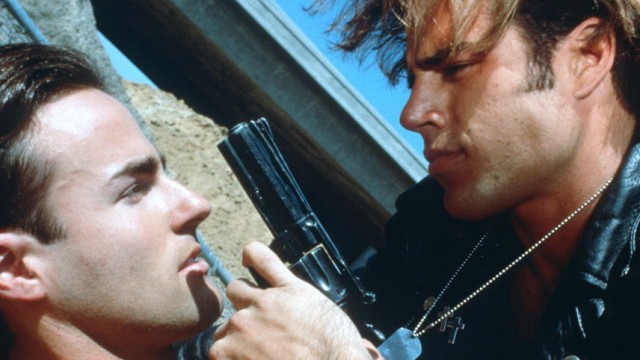Gregg Araki’s first movie, The Living End, released in 1992, was a nihilist scream against the injustice of the AIDS Crisis. I really can’t do better justice to this movie than this review from Washington Post’s Rita Kempley:
A scruffy road movie with Craig Gilmore and Mike Dytri as hunky homosexuals, this pretentious drama on alienation, anger and living outside the law recalls the punk outrage of “Sid and Nancy” and boasts of its cinematic influences — Jean-Luc Godard, Andy Warhol and assorted other poseurs.
Where one woman’s negatives lie, another man’s positives thrive. Referencing Sid and Nancy, Jean-Luc Godard and Andy Warhol in the same sentence? Oh, I’ll be there with bells on.
The central men of The Living End represent the two poles of gay identity. Jon (Craig Gilmore) is a quiet conservative film critic who just discovered he’s HIV Positive, while Luke (Mike Dytri) is a wild and sexy punk hustler who’s been living with HIV long enough to have a Fuck Life attitude. Jon is morbid and morose while Luke is cynically pissed off. After a run in with a bunch of gay bashers, their rage suddenly has a body count and they Thelma and Louise it into the Great American nowhere.
Originally titled Fuck the World, and proudly/cynically labeled as “An Irresponsible Film by Gregg Araki,” The Living End is one big middle finger to the idea of respectability earning respect. In the early 90s, everybody was getting pissed off including the gays who had been dying off for the better part of a decade. Suddenly gay cinema was releasing pissed off movies like Todd Haynes’ Poison (1991), Bruce LaBruce’s skinhead arthouse porno No Skin Off My Ass (1991), and Tom Kalin’s Swoon (1992), an arthouse retelling of the Leopold and Loeb thrill kill. If society was going to allow us to die off, fuck ’em.
Araki’s usual fetishes are on full display here: sterile and surreal interiors, expansive exteriors, overstuffed frames, and a soundtrack populated by industrial and shoegaze. Gregg Araki’s first films had a finger on the pulse of pop culture, making movies that fit in the exact moment they were released. The Living End is a full-on display of 1992, just as the kids spurred by the angst movements were questioning their surroundings, so too was Araki questioning the lives of comfort that we build around us. Araki asked an eternal question, “When you have nothing left to live for, what next?”
The Living End is available streaming on Netflix.

